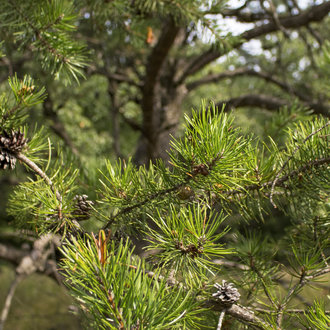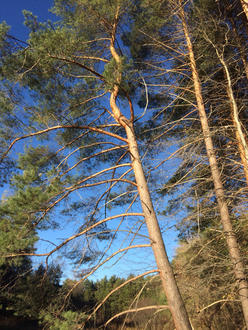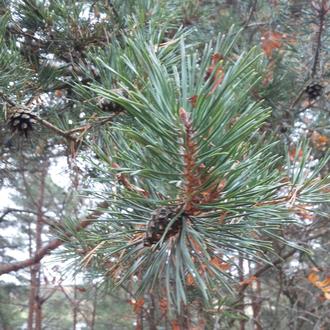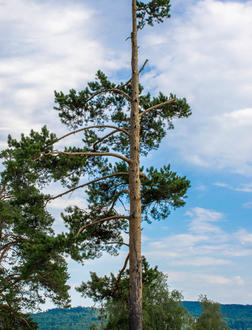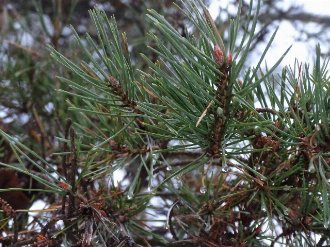Scots Pine (Pinus sylvestris L.)
Also known as Scotch pine.
↑Summary
A pine with short, blue-green needles and orange-red upper bark, native to northern Europe and Siberia, introduced in North America where it has become invasive in some regions.
↑Range - Expand
| Legend | Color |
| Introduced or Not Present | |
| Introduced |
This tentative map is based on our own research. It may have limited data on Canada and/or Mexico, and there is some subjectivity in our assignment of plants as introduced vs. expanded. Read more in this blog post.
Although this plant occurs somewhere in each of these regions, it may only occur in a small part of some or all of them.
↑Similar Plants
↑Habitat
In its native habitat, this species grows on a wide range of different soil types, but is generally limited to sites where harsh conditions limit growth of other species, usually sites with nutrient-poor soils, including both dry and wet sites, such as rock outcroppings, areas with excessively-drained sands, and in bogs. Tolerates soil pH between 4.0 and 7.0, but prefers pH between 4.5 and 6.0. Requires high light conditions and intolerant of shade.
The habitat preferences of this species in North America are not well known, but it seems to function mostly as a pioneer species on sites with sandy soils. In the wild, especially in New York state where it is widely established, it often grows in association with black cherry (Prunus serotina), red maple (Acer rubrum), and quaking aspen (Populus tremuloides), and eastern white pine (Pinus strobus), and also tends to grow with American beech (Fagus grandifolia) and sugar maple (Acer saccharum) which likely seed in later and replace it.
It also readily colonizes anthropogenic habitats, especially in areas with sandy soils, where it is found along roadsides and in firebreaks. Trees can also occasionally establish on gravely substrates in urban areas. More tolerant of urban conditions, including pollution and soil compaction, than most pines.
In recent years, reproduction of this species in New York state has been severely hindered by scleroderris canker (Gremmeniella abietina) which seems to hit this species harder than native pines.
↑Life Cycle
Seedlings grow rapidly, with faster-growing varieties (those derived from central European populations) averaging up to 2.5 feet per year. Shoot growth tends to happen in a single, rapid growth spurt, with 90% of the growth happening in a 3 week period. Each year, trees produce one new whorl of branches. Trees usually grow with a single trunk over most of their length, but especially higher up, the trunk may lean or become contorted.
The root system this species develops varies widely by site. Taproots are more likely to form on deep, sandy soils. Sometimes trees may not initially develop a taproot, but a lateral root will turn downwards to function like a taproot. Most of the roots, however, are lateral and near the surface, although deeper roots tend to develop on drier sites. The root system tends to expand gradually as the tree matures, and a mature tree may have a root system covering as much as 0.3 acres. The growth of the root system is aggressive, and often sufficient to out-compete ther more shade-tolerant species on sites where growth is limited by moisture and/or nutrients, and this species' competitiveness in the root zone may explain its success on such sites.
Although most trees produce both female and male flowers, it is common for shoots and branches, and occasional for entire trees, to produce only flowers of a single sex.
Seed production may begin as soon as 5-8 years on favorable sites, but more commonly, begins at 10-15 years, and sometimes later. Seed production may continue for as long as 200 years, but tends to decline as the tree ages. Good seed crops occur irregularly every 3-6 years, with only light seed production in other years. Seed cones ripen in late October and begin to open gradually, with much of the seed not being released until December. Seed dispersal over crusted snow can result in seeds traveling long distances, up to 0.6 miles, although most seeds remain closer to the parent tree.
Trees cannot resprout and do not reproduce vegetatively. Trees of any age are shade-intolerant and will die rather quickly if overtopped by a canopy of other trees.
In North America, this species is also rather fragile and can easily die of a wide variety of natural causes. Young trees are highly susceptible to fire, and mature trees are still more susceptible to severe fires than many native pines. Trees can be broken off by windstorms. Pine grosbeaks frequently cause substantial damage to trees by eating buds, and porcupines can girdle young trees. There are also numerous insects, both native and introduced, that cause substantial damage to trees, killing them at various stages of their life cycle.
Much of these causes of mortality may result from this species originating in plantations derived from seed sources taken from populations in unsuitable climates. Trees are then poorly adapted to the local climate, and become stressed.
↑Faunal Associations
Scots pine supports a wide variety of insects, mostly ones that eat pines in general, some that more broadly eat conifers.
The seeds are eaten by a variety of birds, as well as squirrels and mice. The foliage are browsed by deer and elk. In its native range it is also browsed by moose, but we did not find records of moose eating introduced populations in North America. Porcupines also eat the bark.
The trees are also used as nesting sites for several songbirds, and as cover and roosting sites by a larger number of birds.
↑Control
Scots pine is relatively easy to control; the most important measure is to avoid planting it in regions where it is invasive.
Because this species cannot resprout, cutting or top-killing all trees is sufficient to permanently remove it from a site as long as there is no nearby population (within 0.6mi / 1km) from which it can recolonize. In some circumstances, larger trees with good form can be harvested for lumber or ones with poor form used for pulp, recouping some of the control costs.
Individiual seedlings can be pulled by hand, and saplings too large to uproot can be cut. Large monocultures can be controlled by herbicides; this species is susceptible to glyphosate and triclopyr, among others, but herbicides are not suitable for where seedlings are competing with other more desirable native vegetation.
↑Uses
Widely used as a landscaping plant, where it is valued for the distinctive color to its bark and needles, its resistance to deer browsing, and its tolerance of a wide range of conditions, including those in cities and gardens.
Also sometimes grown in plantations for timber. Its wood is valued for its workability and straight grain, and is widely used both in construction and as pulp. Trees grown in more northerly climates tend to produce higher-quality wood that is denser and finer-grained, owing to their slower growth.
Historically, in Europe, the litter from this species was collected for animal bedding and fuel.
It has been planted for erosion control and reclamation of degraded sites, particularly reforestation of coal mine spoils, where it tolerates soil pH down to 4.0, more acidic than most pines but not quite as low as tolerated by pitch pine (Pinus rigida).
It is the most commonly-used Christmas tree in the U.S., where it is valued for its short needles and high retention of needles.
Its use in North America is now discouraged, and it is considered invasive in many states. It is also somewhat unreliable as a timber species in North America, due to numerous complications and potential causes of mortality ond deformation when grown in plantations. However, its use as Christmas trees has fewer ecological impacts, as trees are harvested before reaching reproductive maturity. It can also be grown for Christmas trees on coal mine spoils, providing economic value out of degraded land while simultaneously help restore the soil. On richer sites, it use for Christmas trees can be combined with row crops.
↑Related Plants
The native pine most closely related to this species is red pine (Pinus resinosa); it is also closely-related to many other European pines. Of these, the only that occurs widely in North America is Austrian pine (Pinus nigra), which is frequently planted in landscaping and sometimes also establishes wild populations.
↑Notes
The ecological impact of Scots pine in North America is different from most invasive tree species, in that it supports a great deal of insect diversity, not markedly less than native pines. It also tends to be eliminated from forests over time.
However, due to its more aggressive root system, its seedlings can outcompete native pines, red pine (Pinus resinosa) and eastern white pine (Pinus strobus) in the north of its range, and other pines farther south. But, in North America, it tends to be shorter-lived than these species. Red and white pine in particular are long-lived species that tower over a forest long after more shade-tolerant trees seed in under them. As the tallest trees in forests, persisting for hundreds of years, red and white pine contribute greatly to the structure and total biomass of an ecosystem, long after the early-successional stages in which they established.
In North America, Scots pine rarely reaches more than 60 feet in height, much smaller than the 150+ft heights typical of old growth white pine, and shorter even than the 80ft heights typical of mature white pine nowadays. Its lifespan in its native range slightly shorter than white and red pine, but in North America, it can be even further reduced by disease and insect infestations. But by the time it dies, forests are often in too late a stage of succession for native pines, especially red pine, to successfully establish. When it out-competes native pines in early-successional stages of forests, it thus can contribute to absences of pine on a much longer time scale.
↑Links & External Resources
• Scots Pine | The Wood Database (About This Site)
• Scots Pine | Fire Effects Information System (FEIS) (About This Site)
• Pinus sylvestris (Scots Pine) | Illinois Wildflowers (About This Site)
• Pinus sylvestris (Scots Pine) | USDA PLANTS Database (About This Site)
• Pinus sylvestris | Go Botany (About This Site)
• Pinus sylvestris (Scotch Pine) | Missouri Botanical Garden Plant Finder (About This Site)
• Scots Pine | Virginia Tech Dendrology Factsheets (About This Site)
• Scotch Pine | Silvics of North America (About This Site)
• Pinus sylvestris | Biota of North America Project (BONAP) (About This Site)
• Pinus sylvestris | NatureServe Explorer (About This Site)
• Pinus sylvestris | Flora of North America (About This Site)
• Scots Pine | Maryland Biodiversity Project (About This Site)




